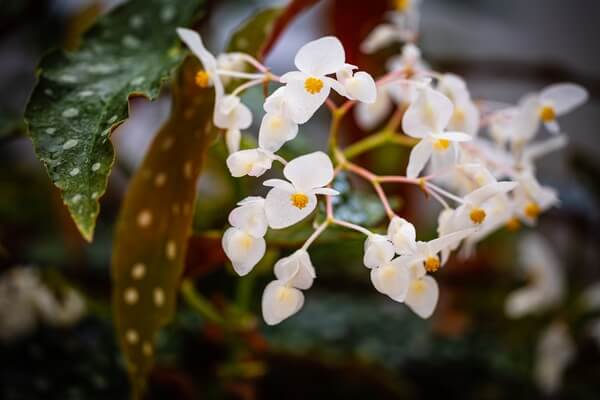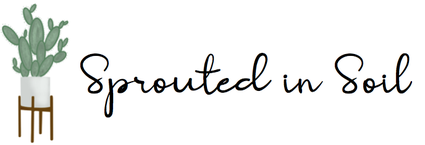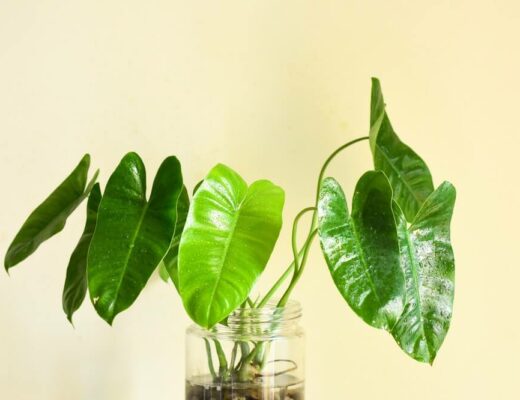The Polka Dot Begonia is one of my all time favorite plants. Rippled, wing-shaped leaves are a deep olive green on top with a bronze burgundy bottom. The top of the leaves are marked with silver (yes, truly silver!) dots.
This whimsical and magical plant is fast growing and easy to care for. The Polka Dot Begonia is one of the most uniquely embellished plants and absolutely commands attention as it grows! Let’s take a deep dive into the best Polka Dot Begonia care!
Table of contents
The Polka Dot Begonia is known by many names! It is known by its scientific name, Begonia maculata var. Wightii. Other common names you may have heard include the Spotted Begonia, Angel Wing Begonia or Trout Begonia. The Polka Dot Begonia is native to South America, specifically in the Atlantic Rainforest which spans multiple Brazilian states. It has since been introduced to countries with similar environments, such as Mexico, Cuba and Argentina.

The Polka Dot Begonia was first discovered in the 1980s and has since made its way comfortably into the home setting. This is a fabulous houseplant that requires minimal care but gives a maximum payoff. Let’s dive into all the things about Begonia maculata care!
Quick Facts

- Common Name: Polka Dot Begonia, Spotted Begonia, Angel Wing Begonia, Trout Begonia
- Scientific Name: Begonia maculata var. Wightii
- Mature Size: five feet tall
- Sunlight: bright, indirect sunlight
- Water: when top ⅓ of soil is dry
- Soil: well-draining
- Temperature: 55°F-85°F with high humidity
- Propagation: stem cuttings
- Toxicity: toxic to humans and pets
Growth Pattern and Habits
Begonia maculata var. Wightii, or Polka Dot Begonia, is a variety of cane begonia. This is a classification that indicates the upright growth of the plant in woody segments similar to bamboo. It is not uncommon for this beautiful indoor plant to reach heights upwards of four to five feet tall!
Expert Tip – Because of its fast, branching growth pattern, it is helpful to add support sticks as your Polka Dot Begonia matures. Using plant clips, support rogue stems to stabilizer sticks to encourage upright growth and to prevent stems from breaking.
Because the Polka Dot Begonia is of the cane variety, this plant grows up and branches out on segmented stems that produce the eye-catching foliage. The leaves are asymmetrical and look similar to pointed wings. The “wing tips” always point downwards creating a beautiful curtain around the stems.
Leaves appear on alternating sides of the stem. They unfurl from a tight spiral, slowly growing larger and larger. Young leaves are extremely tender and have a translucent soft pink glow. As the leaf matures, the color becomes more solid and the dots more distinguished! A well cared for Polka Dot Begonia can grow leaves up to eight inches long and a couple inches across.

The Polka Dot Begonia is a fast growing houseplant. If given proper Polka Dot Begonia care, your plant can grow up to twelve inches per spring and summer growing season! It can, however, become a bit stretched out and thin. To encourage more full growth, prune the top third of your Polka Dot Begonia using a sterilized knife or cutters. Don’t throw away the removed stems. These cuttings can be used for propagation! Learn how to propagate Polka Dot Begonias by skipping to the propagation section below.
Expert Tip – Because Polka Dot Begonias grow so quickly, it is best to repot every two to three years with fresh soil in a pot that is one inch larger in diameter than the previous. The best type of pot for a Polka Dot Begonia is a terracotta pot.
You can also “pinch” your Polka Dot Begonia to stimulate your plant to create two branching stems from one point. At the end of a stem with leaves, there is a small, thin tender growing tip that can be removed. Once removed and as plant growth continues, two stems will branch off from this previously singular point.
You will notice that leaves unfurl from a protective, green sheath. As the leaf matures, this sheath will turn brown and crusty. To keep your plant looking great, remove the old sheathes. This not only improves the plant’s appearance, it also is an easy way to avoid pest infestations. In addition to removing the dead sheathes, remove the lower leaves that will eventually age and die.

Another exciting trait of the Polka Dot Begonia is that it flowers indoors much more reliably than other houseplants. When provided with appropriate sunlight and watering, an indoor Begonia maculata will bloom beginning in mid summer and flowers last up to six weeks! To encourage the blooming of Polka Dot Begonia flowers, switch from a balanced fertilizer to one high in potassium. You will be blown away by the bell-shaped white Polka Dot Begonia flowers that have bright yellow centers.
Sunlight
A Polka Dot Begonia will do best when grown in light that mimics its natural habitat. Polka Dot Begonia light requirements are quite simple. It needs very bright but indirect light for the majority of the day, all year long.

East or west facing windows in a bright room are a great home for your Polka Dot Begonia. Another option is just out of reach of direct afternoon sunlight in a south facing window. Too much direct sunlight, especially rays from the harsh afternoon sun, will cause leaf damage and stunted growth.
It is ok if your plant receives moderate amounts of direct early to mid-morning sunlight or gentle evening rays. This light is not strong enough to cause damage. Too little light, however, can also cause stunted growth in addition to extreme legginess and faded spots.
Water
Begonia maculatas like to be slightly moist. Afterall, they are native to humid, steamy rainforests, and to be the very best plant parents, we need to strive to provide this indoors. Give your Polka Dot Begonia a thorough watering when the top third of the soil is dry to the touch. This strikes a good balance between keeping your plant happily damp but not at all soggy!
You can go about Polka Dot Begonia watering two ways. The first is by soaking the soil at the base of the plant and watering from the top down. Be sure to not get the leaves wet. The second way is to water from the bottom up by placing the pot in a container of water. Water will soak up through the bottom drainage hole and spread to the roots.

Signs of consistent overwatering are most obviously noted in the leaves. An overwatered Polka Dot Begonia will have yellowed leaves with brown or pale blotches. They will appear wilted and be slightly mushy to the touch. Stems may also show signs of discoloration. Overwatering can cause root rot and can make the plant more susceptible to pests and infections.
Underwatered Polka Dot Begonias will have brown crispy leaves that are brittle to the touch. Underwatering is most likely to occur during the warm months when the plant needs more water to support its rapid growth.
Soil
Polka Dot Begonias do best in well-draining soil. I have found that a simple organic potting soil with added perlite is great! To make the best Polka Dot Begonia soil, mix three parts potting soil with one part perlite.

The best pot for Polka Dot Begonias is terracotta pots. This material is very breathable and encourages evaporation of excess water. The combination of well-draining soil in a porous container like terracotta, will provide the best environment for your indoor Begonia maculata.
Expert Tip – Make large batches of Begonia maculata soil mixes so the components are well mixed throughout.
Temperature and Humidity
Average household temperatures are completely suitable for growing a Polka Dot Begonia. Specifically, this plant prefers temperatures between 55°F-85°F with warmer temperatures during the spring and summer and slightly cooler temperatures in the winter.
Expert Tip – By mimicking the change in temperature indoors to match the seasons, this encourages your Begonia maculata to enter a dormant period. Doing so will greatly increase the chance of flowers!
Polka Dot Begonias like humidity, which is no surprise given their natural habitat. Correctly watering provides this plant with a consistent source of humidity, however if you live in a drier climate, use of a pebble tray will raise humidity to a suitable level. Keep Polka Dot Begonias away from vents.
Fertilization
For the majority of the year, Polka Dot Begonias need a balanced fertilizer. A balanced fertilizer has equal parts of nitrogen, phosphorus and potassium. These ratios will be printed on a fertilizers label. A balanced fertilizer will have equal values for N-P-K and will be listed as such (for example, 5-5-5).

Starting in the spring and through the beginning of fall, fertilize your Polka Dot Begonia once every three to four weeks. In the cooler months, especially if you notice slowed growth, fertilize every eight weeks.
To encourage your Polka Dot Begonia to bloom, switch to a fertilizer higher in potassium from late June to early September. Outside of this period, only use a balanced fertilizer.
Expert Tip – Always, ALWAYS, read and follow the instructions listed on the fertilizer container to properly dilute the product!
Propagation
Polka Dot Begonia propagation is easy and is best done by using stem cuttings! I propagate all of my Polka Dot Begonia cuttings in water so I can easily monitor root growth before planting in soil. Here are the steps to Polka Dot Begonia Propagation:
- Choose healthy mature stems to propagate. Mature stems are stems that are in the middle to lower areas of the plant and should be at least three to four inches long.
- Using sterile scissors or a sterile knife, remove the stems from the mature Polka Dot Begonia plant. Ensure there are at least two bare growth nodes on the cutting or remove the bottom two leaves on the cutting. This is where new growth develops.

- Place the stem cutting in fresh, room temperature water. Only the bare nodes should be submerged in water. Leaves should not touch the water as this can lead to problems such as rot or fungus.
- The Polka Dot Begonia cuttings should be in bright, indirect sunlight. Change the water every three to four days or earlier if you notice discoloration.
- Within three to four weeks, you will notice root growth. Once the new roots are over two inches long, transplant into fresh soil. At this point begin to care for the new Polka Dot Begonia as you would a mature plant.
Expert Tip – You can choose to propagate Begonia maculata directly into soil. I choose the above method as it allows you to monitor root growth
Common Problems
The Polka Dot Begonia is not without its issues! Polka Dot Begonia care is easy but there are a few things to look out for. This following list is a nice summary of things to look out for and how to deal with them!
Rust
Rust is a disease (nothing to do with rusting metal) caused by a group of fungi. Symptoms of rust include the following:
- Red, yellow or orange spots on the leaves
- Raised spores that have a fluffy appearance
- Yellowed, brown and dropping leaves

Rust needs water to survive. Wet leaves from improper watering or misting of the Polka Dot Begonia is a factor that increases the likelihood of an overgrowth of rust. Before buying a Polka Dot Begonia look for signs of discoloration or these small spots.
Pinch off rusted leaves, pruning no more than ⅓ of the plant at a time. Take a close look at your watering habits to determine if your Begonia maculata may be getting a bit too much.
Powdery Mildew
Polka Dot Begonias are susceptible to powdery mildew because of their desire to be in a perpetual, slightly moist environment. Another type of fungus that affects indoor Polka Dot Begonias, powdery mildew can be identified easily. You will note white, fluffy patches affecting both leaves and stems.

Because an overgrowth of powdery mildew is caused by too much moisture and poor air circulation, it can be a fairly easy fix if caught early. Manage your watering schedule by always checking the top soil first. Be sure that your Polka Dot Begonia isn’t squished together with a crowd of other plants. Prune away any infected leaves and stems.
Yellowing Leaves
The most common cause of yellowing leaves is overwatering. The leaves will be soft, mushy and limp to the touch. If a small portion of the plant is showing signs of overwatering, simply hold off watering for a couple of weeks, then resume with a more conservative watering schedule.

If the majority of the Polka Dot Begonia has signs of overwatering then gently remove the entire plant from the pot and shake off excess soil. Let the roots air out for a couple of days before repotting in fresh soil.
Expert Tip – Examine the roots. If the roots are dark and discolored or feel soft and slimy, your plant is experiencing root rot. Prune away all affected roots before repotting.
Brown Leaf Tips or Yellow Halos
This is most caused by too much direct sun and not enough humidity. The Polka Dot Begonia needs bright light but it should mostly be diffuse and indirect. If this plant receives too much direct sun during the middle portion of the day, it will likely show signs of damage.
Likewise, these symptoms can be a sign of too little humidity. Place your Polka Dot Begonia on a pebble tray and be sure that it is housed away from vents and drafts.
Pests
The two most common pests that like to feast on Polka Dot Begonias are spider mites and aphids. Spider mites are a small class of arachnids. They look like small brown, black or red dots the size of pencil tips. Spider mites create fine, white webbing between leaves and stems. Treat by removing all webs and spider mites using an alcohol soaked cotton ball and spray the plant with neem oil.
Aphids are small soft-bodied insects that can be green or brown in color. This insect feeds on the sap of plants and can be devastating. Remove all signs of aphids with an alcohol soaked cotton ball. Treat the plant with neem oil.
Expert Tip – As a preventative measure, lightly spray your Polka Dot Begonia monthly with neem oil
For more information about houseplant pests, use this post as a resource.
Toxicity
You will want to put your Polka Dot Begonia on display for everyone to admire however take care to keep it out of the reach of pets and kids. Begonias contain soluble calcium oxalates which cannot be digested by humans or household pets.

If ingested, the first signs to be noted are excess salivation and vomiting. Remove all visible parts of the plant from the mouth and reach out to the appropriate emergency services.
Conclusion
The Polka Dot Begonia, also known as the Begonia maculata, is a stunning houseplant. The olive green leaves with silvery, reflective spots are extremely unique! This plant grows quickly and needs to be stabilized as it grows. Enjoy small white flowers that bloom in the mid summer months and last for weeks.
Begonia maculata propagation is simple and straightforward. Correctly water your plant and keep it well groomed to avoid pests and diseases! With this information, even a plant-newbie can provide excellent Begonia maculata care.




